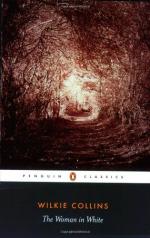There he lay, unowned, unknown, exposed to the flippant curiosity of a French mob! There was the dreadful end of that long life of degraded ability and heartless crime! Hushed in the sublime repose of death, the broad, firm, massive face and head fronted us so grandly that the chattering Frenchwomen about me lifted their hands in admiration, and cried in shrill chorus, “Ah, what a handsome man!” The wound that had killed him had been struck with a knife or dagger exactly over his heart. No other traces of violence appeared about the body except on the left arm, and there, exactly in the place where I had seen the brand on Pesca’s arm, were two deep cuts in the shape of the letter T, which entirely obliterated the mark of the Brotherhood. His clothes, hung above him, showed that he had been himself conscious of his danger—they were clothes that had disguised him as a French artisan. For a few moments, but not for longer, I forced myself to see these things through the glass screen. I can write of them at no greater length, for I saw no more.
The few facts in connection with his death which I subsequently ascertained (partly from Pesca and partly from other sources), may be stated here before the subject is dismissed from these pages.
His body was taken out of the Seine in the disguise which I have described, nothing being found on him which revealed his name, his rank, or his place of abode. The hand that struck him was never traced, and the circumstances under which he was killed were never discovered. I leave others to draw their own conclusions in reference to the secret of the assassination as I have drawn mine. When I have intimated that the foreigner with the scar was a member of the Brotherhood (admitted in Italy after Pesca’s departure from his native country), and when I have further added that the two cuts, in the form of a T, on the left arm of the dead man, signified the Italian word “Traditore,” and showed that justice had been done by the Brotherhood on a traitor, I have contributed all that I know towards elucidating the mystery of Count Fosco’s death.
The body was identified the day after I had seen it by means of an anonymous letter addressed to his wife. He was buried by Madame Fosco in the cemetery of Pere la Chaise. Fresh funeral wreaths continue to this day to be hung on the ornamental bronze railings round the tomb by the Countess’s own hand. She lives in the strictest retirement at Versailles. Not long since she published a biography of her deceased husband. The work throws no light whatever on the name that was really his own or on the secret history of his life—it is almost entirely devoted to the praise of his domestic virtues, the assertion of his rare abilities, and the enumeration of the honours conferred on him. The circumstances attending his death are very briefly noticed, and are summed up on the last page in this sentence—“His life was one long assertion of the rights of the aristocracy and the sacred principles of Order, and he died a martyr to his cause.”




